check engine CITROEN RELAY 2017 Handbook (in English)
[x] Cancel search | Manufacturer: CITROEN, Model Year: 2017, Model line: RELAY, Model: CITROEN RELAY 2017Pages: 292, PDF Size: 9.04 MB
Page 35 of 292
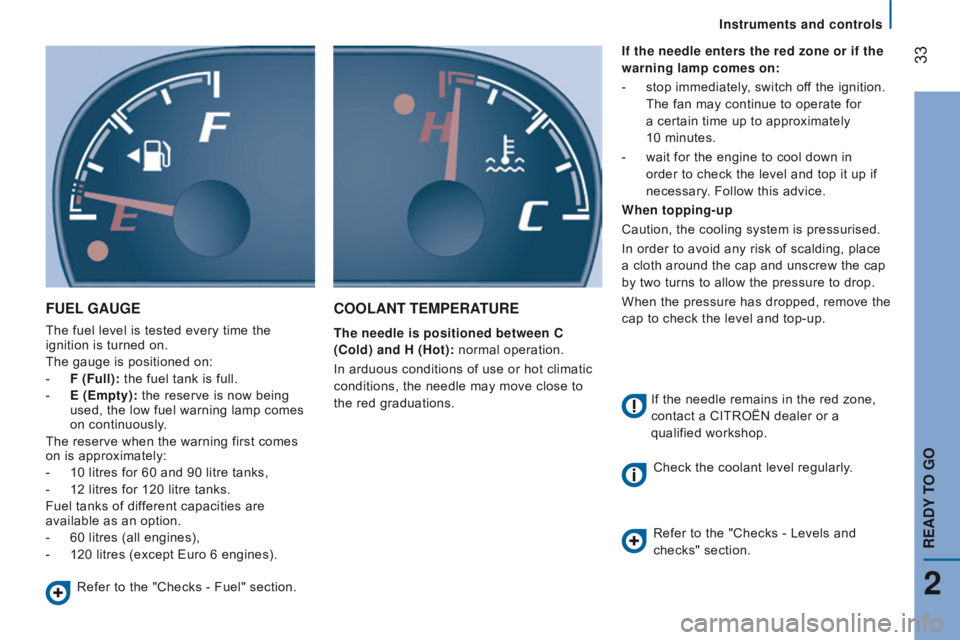
33
FuEL GA u GE
The fuel level is tested every time the
ignition is turned on.
The gauge is positioned on:
-
F (Full):
the fuel tank is full.
-
E (Empty):
the reserve is now being
used, the low fuel warning lamp comes
on continuously.
The reserve when the warning first comes
on is approximately:
-
10 litres for 60 and 90 litre tanks,
-
12 litres for 120 litre tanks.
Fuel tanks of dif
ferent capacities are
available as an option.
-
60 litres (all engines),
-
120 litres (except Euro 6 engines).
cOOLAnt tEMPErAtur E
the needle is positioned between c
( c old) and H (Hot): normal operation.
In arduous conditions of use or hot climatic
conditions, the needle may move close to
the red graduations. If the needle enters the red zone or if the
warning lamp comes on:
-
stop immediately
, switch off the ignition.
The fan may continue to operate for
a certain time up to approximately
10 minutes.
-
wait for the engine to cool down in
order to check the level and top it up if
necessary. Follow this advice.
When topping-up
Caution, the cooling system is pressurised.
In order to avoid any risk of scalding, place
a cloth around the cap and unscrew the cap
by two turns to allow the pressure to drop.
When the pressure has dropped, remove the
cap to check the level and top-up.
Refer to the "Checks - Fuel" section. If the needle remains in the red zone,
contact a CITROËN dealer or a
qualified workshop.
Check the coolant level regularly.
Refer to the "Checks - Levels and
checks" section.
2
rEAdY tO GO
Instruments and controls
Page 38 of 292
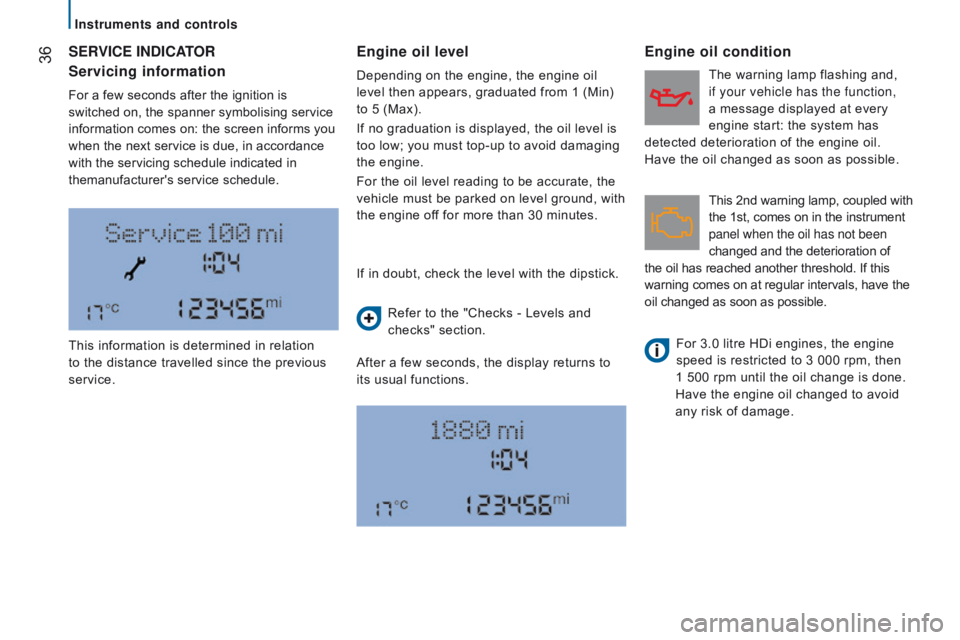
36SErVIc E I nd I c AtO r Engine oil level
After a few seconds, the display returns to
its usual functions.
Engine oil condition
If in doubt, check the level with the dipstick. This 2nd warning lamp, coupled with
the 1st, comes on in the instrument
panel when the oil has not been
changed and the deterioration of
the oil has reached another threshold. If this
warning comes on at regular intervals, have the
oil changed as soon as possible. The warning lamp flashing and,
if your vehicle has the function,
a message displayed at every
engine start: the system has
detected deterioration of the engine oil.
Have the oil changed as soon as possible.
For 3.0 litre HDi engines, the engine
speed is restricted to 3 000 rpm, then
1 500 rpm until the oil change is done.
Have the engine oil changed to avoid
any risk of damage.
Servicing information
For a few seconds after the ignition is
switched on, the spanner symbolising service
information comes on: the screen informs you
when the next service is due, in accordance
with the servicing schedule indicated in
themanufacturer's service schedule. Depending on the engine, the engine oil
level then appears, graduated from 1 (Min)
to 5 (Max).
If no graduation is displayed, the oil level is
too low; you must top-up to avoid damaging
the engine.
For the oil level reading to be accurate, the
vehicle must be parked on level ground, with
the engine off for more than 30 minutes.
Refer to the "Checks - Levels and
checks" section.
This information is determined in relation
to the distance travelled since the previous
service.
Instruments and controls
Page 39 of 292
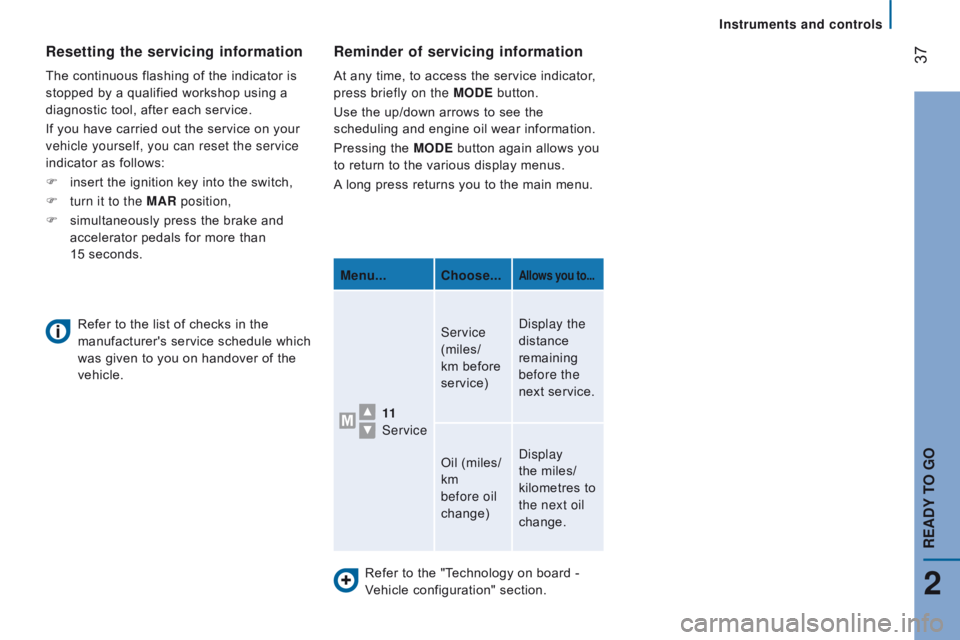
37
Refer to the "Technology on board -
Vehicle configuration" section.
reminder of servicing information
At any time, to access the service indicator,
press briefly on the MOd E button.
Use the up/down arrows to see the
scheduling and engine oil wear information.
Pressing the MO
d E button again allows you
to return to the various display menus.
A long press returns you to the main menu.
Menu...
c
hoose...
Allows you to...
11
Service Service
(miles/
km before
service)
Display the
distance
remaining
before the
next service.
Oil (miles/
km
before oil
change) Display
the miles/
kilometres to
the next oil
change.
Refer to the list of checks in the
manufacturer's service schedule which
was given to you on handover of the
vehicle.
resetting the servicing information
The continuous flashing of the indicator is
stopped by a qualified workshop using a
diagnostic tool, after each service.
If you have carried out the service on your
vehicle yourself, you can reset the service
indicator as follows:
F
insert the ignition key into the switch,
F
turn it to the
MA r position,
F
simultaneously press the brake and
accelerator pedals for more than
15
seconds.
2
rEAdY tO GO
Instruments and controls
Page 42 of 292
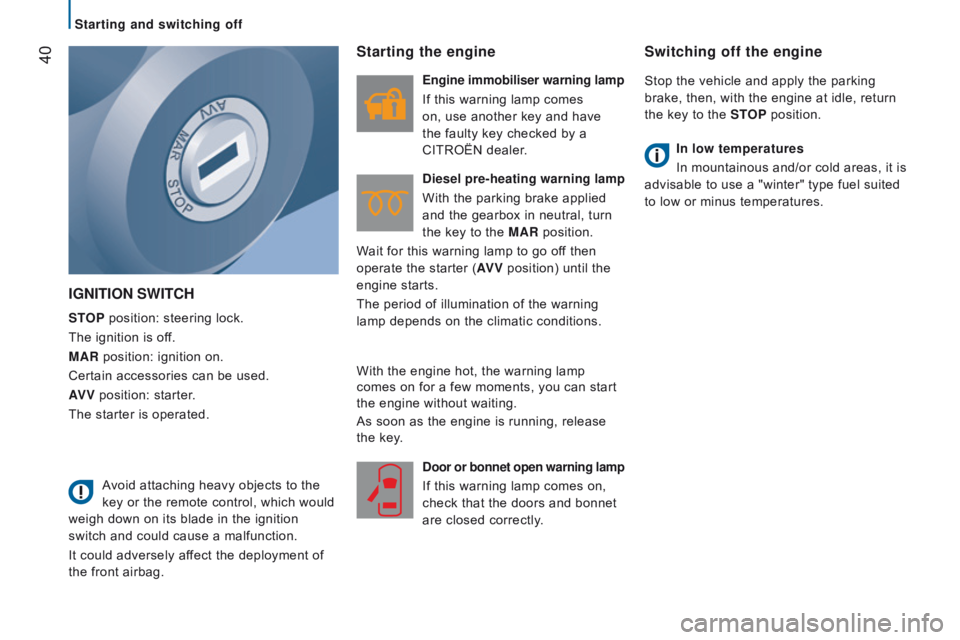
40
IGnItIOn SWItcH
StOP position: steering lock.
The ignition is off.
MA
r position: ignition on.
Certain accessories can be used.
AV V position: starter.
The starter is operated.
Starting the engine
Engine immobiliser warning lamp
If this warning lamp comes
on, use another key and have
the faulty key checked by a
CITROËN dealer.
d
iesel pre-heating warning lamp
With the parking brake applied
and the gearbox in neutral, turn
the key to the MA
r position.
Wait for this warning lamp to go off then
operate the starter (AV V position) until the
engine starts.
The period of illumination of the warning
lamp depends on the climatic conditions.
d
oor or bonnet open warning lamp
If this warning lamp comes on,
check that the doors and bonnet
are closed correctly.
Switching off the engine
Stop the vehicle and apply the parking
brake, then, with the engine at idle, return
the key to the S
t
OP
position.
In low temperatures
In mountainous and/or cold areas, it is
advisable to use a "winter" type fuel suited
to low or minus temperatures.
Avoid attaching heavy objects to the
key or the remote control, which would
weigh down on its blade in the ignition
switch and could cause a malfunction.
It could adversely affect the deployment of
the front airbag. With the engine hot, the warning lamp
comes on for a few moments, you can start
the engine without waiting.
As soon as the engine is running, release
the key.
Starting and switching off
Page 44 of 292
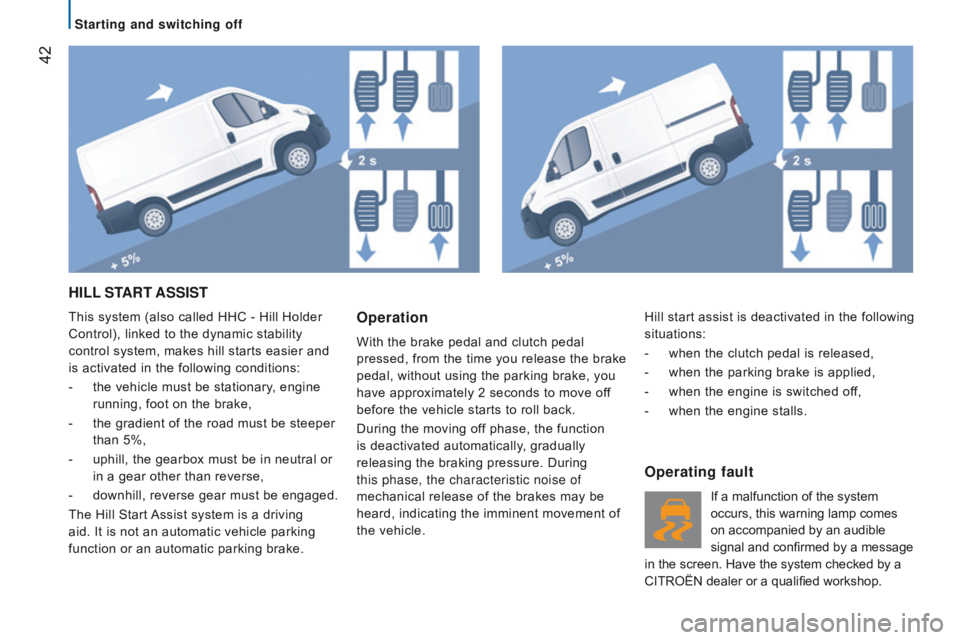
42
HILL StA rt ASSIS t
This system (also called HHC - Hill Holder
Control), linked to the dynamic stability
control system, makes hill starts easier and
is activated in the following conditions:
-
the vehicle must be stationary
, engine
running, foot on the brake,
-
the gradient of the road must be steeper
than 5%,
-
uphill, the gearbox must be in neutral or
in a gear other than reverse,
-
downhill, reverse gear must be engaged.
The Hill Start
Assist system is a driving
aid. It is not an automatic vehicle parking
function or an automatic parking brake.Operation
With the brake pedal and clutch pedal
pressed, from the time you release the brake
pedal, without using the parking brake, you
have approximately 2 seconds to move off
before the vehicle starts to roll back.
During the moving off phase, the function
is deactivated automatically, gradually
releasing the braking pressure. During
this phase, the characteristic noise of
mechanical release of the brakes may be
heard, indicating the imminent movement of
the vehicle.
Operating fault
If a malfunction of the system
occurs, this warning lamp comes
on accompanied by an audible
signal and confirmed by a message
in the screen. Have the system checked by a
CITROËN dealer or a qualified workshop. Hill start assist is deactivated in the following
situations:
-
when the clutch pedal is released,
-
when the parking brake is applied,
-
when the engine is switched of
f,
-
when the engine stalls.
Starting and switching off
Page 47 of 292
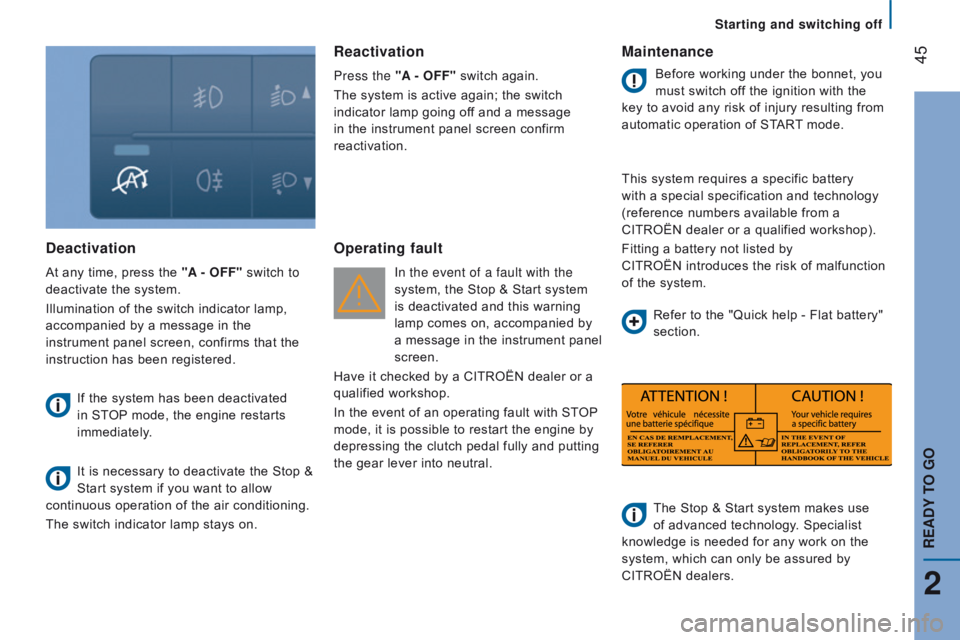
45
deactivation
At any time, press the "A - OFF" switch to
deactivate the system.
Illumination of the switch indicator lamp,
accompanied by a message in the
instrument panel screen, confirms that the
instruction has been registered.
If the system has been deactivated
in STOP mode, the engine restarts
immediately.
It is necessary to deactivate the Stop
&
Start system if you want to allow
continuous operation of the air conditioning.
The switch indicator lamp stays on.
reactivation
Press the "A - OFF" switch again.
The system is active again; the switch
indicator lamp going off and a message
in the instrument panel screen confirm
reactivation.
Operating fault
In the event of a fault with the
system, the Stop & Start system
is deactivated and this warning
lamp comes on, accompanied by
a message in the instrument panel
screen.
Have it checked by a CITROËN dealer or a
qualified workshop.
In the event of an operating fault with STOP
mode, it is possible to restart the engine by
depressing the clutch pedal fully and putting
the gear lever into neutral.
Maintenance
Before working under the bonnet, you
must switch off the ignition with the
key to avoid any risk of injury resulting from
automatic operation of START mode.
This system requires a specific battery
with a special specification and technology
(reference numbers available from a
CITROËN dealer or a qualified workshop).
Fitting a battery not listed by
CITROËN
introduces the risk of malfunction
of the system.
The Stop & Start system makes use
of advanced technology. Specialist
knowledge is needed for any work on the
system, which can only be assured by
CITROËN dealers. Refer to the "Quick help - Flat battery"
section.
2
rEAdY tO GO
Starting and switching off
Page 48 of 292
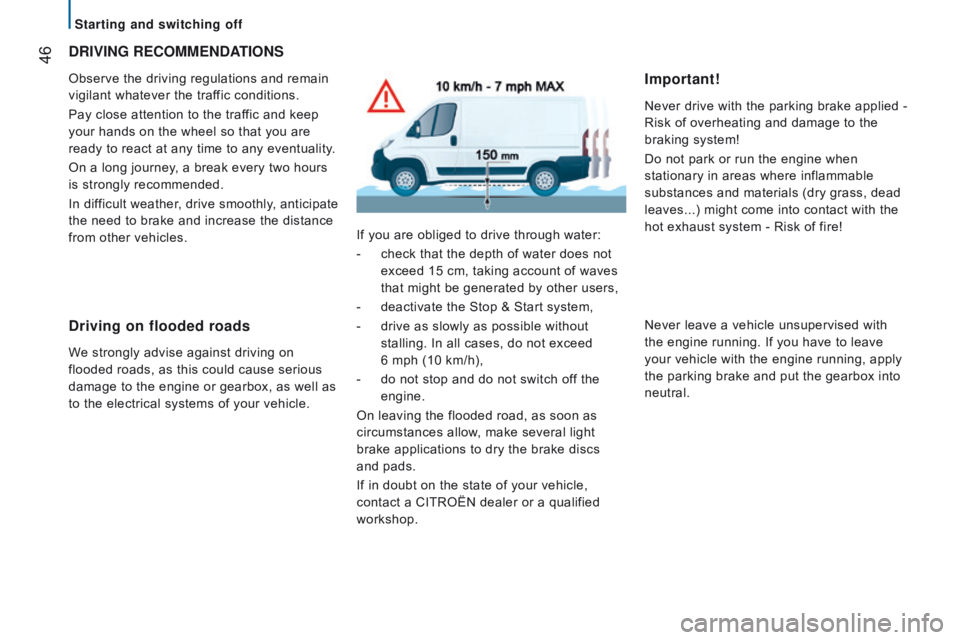
46drIVInG rEcOMMEndAtIO n S
Observe the driving regulations and remain
vigilant whatever the traffic conditions.
Pay close attention to the traffic and keep
your hands on the wheel so that you are
ready to react at any time to any eventuality.
On a long journey, a break every two hours
is strongly recommended.
In difficult weather, drive smoothly, anticipate
the need to brake and increase the distance
from other vehicles.
driving on flooded roads
We strongly advise against driving on
flooded roads, as this could cause serious
damage to the engine or gearbox, as well as
to the electrical systems of your vehicle. If you are obliged to drive through water:
-
check that the depth of water does not
exceed 15 cm, taking account of waves
that might be generated by other users,
-
deactivate the Stop & Start system,
-
drive as slowly as possible without
stalling. In all cases, do not exceed
6 mph (10 km/h),
-
do not stop and do not switch of
f the
engine.
On leaving the flooded road, as soon as
circumstances allow, make several light
brake applications to dry the brake discs
and
pads.
If in doubt on the state of your vehicle,
contact a CITROËN dealer or a qualified
workshop.
Important!
Never drive with the parking brake applied -
Risk of overheating and damage to the
braking system!
Do not park or run the engine when
stationary in areas where inflammable
substances and materials (dry grass, dead
leaves...) might come into contact with the
hot exhaust system - Risk of fire!
Never leave a vehicle unsupervised with
the engine running. If you have to leave
your vehicle with the engine running, apply
the parking brake and put the gearbox into
neutral.
Starting and switching off
Page 76 of 292
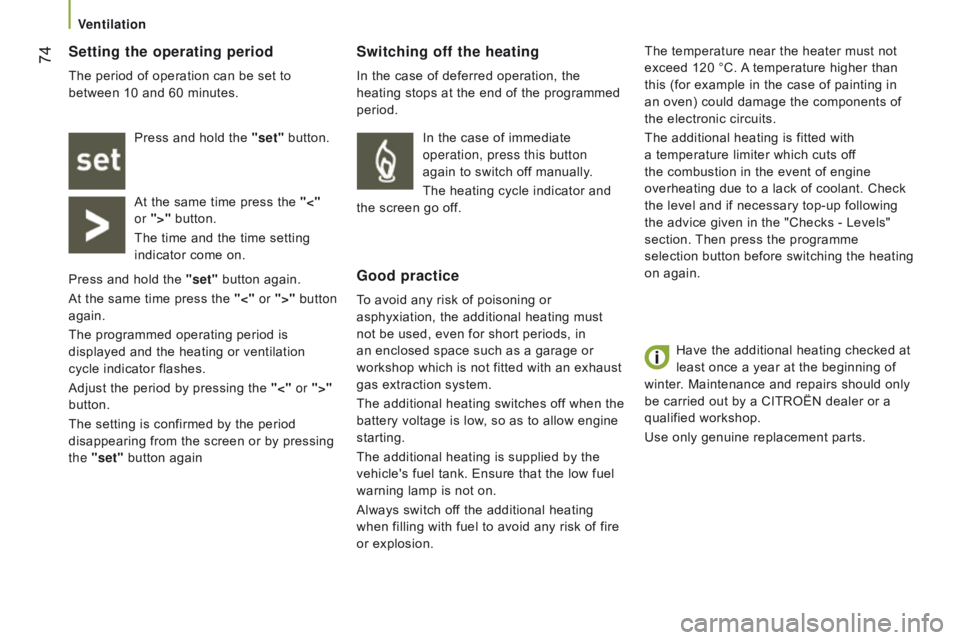
74
Have the additional heating checked at
least once a year at the beginning of
winter. Maintenance and repairs should only
be carried out by a CITROËN dealer or a
qualified workshop.
Use only genuine replacement parts.
Switching off the heating
In the case of deferred operation, the
heating stops at the end of the programmed
period.
Good practice
To avoid any risk of poisoning or
asphyxiation, the additional heating must
not be used, even for short periods, in
an enclosed space such as a garage or
workshop which is not fitted with an exhaust
gas extraction system.
The additional heating switches off when the
battery voltage is low, so as to allow engine
starting.
The additional heating is supplied by the
vehicle's fuel tank. Ensure that the low fuel
warning lamp is not on.
Always switch off the additional heating
when filling with fuel to avoid any risk of fire
or explosion. The temperature near the heater must not
exceed 120
°C. A temperature higher than
this (for example in the case of painting in
an oven) could damage the components of
the electronic circuits.
The additional heating is fitted with
a temperature limiter which cuts off
the combustion in the event of engine
overheating due to a lack of coolant. Check
the level and if necessary top-up following
the advice given in the "Checks - Levels"
section. Then press the programme
selection button before switching the heating
on again.
Setting the operating period
The period of operation can be set to
between 10 and 60 minutes.
Press and hold the "set" button.
At the same time press the "<"
or ">" button.
The time and the time setting
indicator come on.
Press and hold the "set" button again.
At the same time press the "<" or ">" button
again.
The programmed operating period is
displayed and the heating or ventilation
cycle indicator flashes.
Adjust the period by pressing the "<" or ">"
button.
The setting is confirmed by the period
disappearing from the screen or by pressing
the "set" button again In the case of immediate
operation, press this button
again
to switch off manually.
The heating cycle indicator and
the screen go off.
Ventilation
Page 109 of 292

107
trAjEctOrY c O ntr OL SYS t EMS
Switching off
This system cannot be deactivated by
the
driver.
dynamic stability control
( d S c )
The electronic stability programme acts on
the brake of one or more wheels and on the
engine to keep the vehicle on the trajectory
required by the driver, within the limits of the
laws of physics.
With the DSC system, maintain course
without trying to countersteer.
Operation
The DSC system is activated automatically
each time the vehicle is started. Operating fault
Illumination of this warning lamp,
accompanied by an audible signal
and confirmed by a message
in the instrument panel screen,
indicates a fault with the DSC system.
Have it checked by a CITROËN dealer or a
qualified workshop. Operation
This system is activated automatically every
time the vehicle is started.
In the event of a problem of adhesion or
trajectory, this system comes into play.
Switching off
In exceptional conditions (starting a vehicle
which is bogged down, stuck in snow,
on soft ground...), it may be advisable to
deactivate the ASR system, so that the
wheels can spin freely and regain grip.
-
Press this button, located in the
middle of the dashboard, to deactivate
the
system.
Anti-slip regulation (ASr)
Anti-slip regulation (also known as traction
control) optimises traction, avoiding wheel
spin by acting on the brakes of the driving
wheels and the engine.
If the button's warning lamp comes
on, accompanied by a message in the
instrument panel screen, this indicates that
the ASR system is deactivated.
It comes into operation in the
event of a grip or trajectory
problem.
This is indicated by flashing of this warning
lamp in the instrument panel.
5
driving safely
SAFEtY
Page 112 of 292

110
Hill descent control
System that provides assistance when
descending on surfaces with poor grip (mud,
gravel...) or on a steep gradient.
This system reduces the risk of slip or loss
of control of the vehicle while descending
a hill.
It keeps the vehicle at a steady speed during
a descent by acting independently and with
varying force on each of the brakes. Switching off
Press this button, located in the middle of the
dashboard, to deactivate the system; the indicator
lamp in the button goes off.
Above 30 mph (50 km/h), the system is completely
deactivated; the indicator lamp in the button goes off.
Operating fault
If a fault occurs with the hill
descent control system, this
warning lamp comes on.
Have the system checked by a CITROËN
dealer or a qualified workshop.
Switching on
On starting the vehicle, the system is
deactivated.
With the speed below 18 mph (30 km/h)
press this button, located in the middle of
the dashboard, to activate the system; the
indicator lamp in the button comes on.
Once the vehicle starts its descent, you can
release the accelerator and brake pedals;
the indicator lamp in the button flashes.
The brake lamps come on automatically
when the system is brought into operation.
If the speed of the vehicle exceeds 18
mph
(30 km/h), the system is automatically
deactivated, but the indicator lamp in the
button stays on.
The system reactivates automatically as
soon as the speed of the vehicle drops
below 18 mph (30 km/h).
For the system to operate, the slope
must be steeper than 8%.
Do not use the system with the gearbox in
neutral.
Engage an appropriate gear for the speed of
the vehicle, to avoid the engine stalling.
You can press the accelerator or brake
pedal at any time. The system may not be available if the
brakes overheat. Wait a few minutes
for them to cool down before trying again.
driving safely